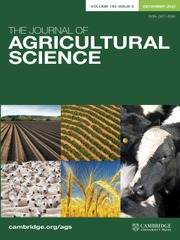Crossref Citations
This article has been cited by the following publications. This list is generated based on data provided by
Crossref.
Kebreab, E.
Dijkstra, J.
Bannink, A.
and
France, J.
2009.
Recent advances in modeling nutrient utilization in ruminants1.
Journal of Animal Science,
Vol. 87,
Issue. suppl_14,
p.
E111.
BANNINK, A.
SMITS, M. C. J.
KEBREAB, E.
MILLS, J. A. N.
ELLIS, J. L.
KLOP, A.
FRANCE, J.
and
DIJKSTRA, J.
2010.
Simulating the effects of grassland management and grass ensiling on methane emission from lactating cows.
The Journal of Agricultural Science,
Vol. 148,
Issue. 1,
p.
55.
van Zijderveld, S.M.
Gerrits, W.J.J.
Apajalahti, J.A.
Newbold, J.R.
Dijkstra, J.
Leng, R.A.
and
Perdok, H.B.
2010.
Nitrate and sulfate: Effective alternative hydrogen sinks for mitigation of ruminal methane production in sheep.
Journal of Dairy Science,
Vol. 93,
Issue. 12,
p.
5856.
Mapato, Chaowarit
Wanapat, Metha
and
Cherdthong, Anusorn
2010.
Effects of urea treatment of straw and dietary level of vegetable oil on lactating dairy cows.
Tropical Animal Health and Production,
Vol. 42,
Issue. 8,
p.
1635.
Chagunda, Mizeck G. G.
Flockhart, Jennifer F.
and
Roberts, David J.
2010.
The effect of forage quality on predicted enteric methane production from dairy cows.
International Journal of Agricultural Sustainability,
Vol. 8,
Issue. 4,
p.
250.
Janssen, Peter H.
2010.
Influence of hydrogen on rumen methane formation and fermentation balances through microbial growth kinetics and fermentation thermodynamics.
Animal Feed Science and Technology,
Vol. 160,
Issue. 1-2,
p.
1.
Place, S.E.
and
Mitloehner, F.M.
2010.
Invited review: Contemporary environmental issues: A review of the dairy industry's role in climate change and air quality and the potential of mitigation through improved production efficiency.
Journal of Dairy Science,
Vol. 93,
Issue. 8,
p.
3407.
ELLIS, J. L.
BANNINK, A.
FRANCE, J.
KEBREAB, E.
and
DIJKSTRA, J.
2010.
Evaluation of enteric methane prediction equations for dairy cows used in whole farm models.
Global Change Biology,
Vol. 16,
Issue. 12,
p.
3246.
Beukes, P.C.
Gregorini, P.
Romera, A.J.
Levy, G.
and
Waghorn, G.C.
2010.
Improving production efficiency as a strategy to mitigate greenhouse gas emissions on pastoral dairy farms in New Zealand.
Agriculture, Ecosystems & Environment,
Vol. 136,
Issue. 3-4,
p.
358.
Bretschger, Orianna
Osterstock, Jason B.
Pinchak, William E.
Ishii, Shun’ichi
and
Nelson, Karen E.
2010.
Microbial Fuel Cells and Microbial Ecology: Applications in Ruminant Health and Production Research.
Microbial Ecology,
Vol. 59,
Issue. 3,
p.
415.
de Menezes, Alexandre B.
Lewis, Eva
O'Donovan, Michael
O'Neill, Brendan F.
Clipson, Nicholas
and
Doyle, Evelyn M.
2011.
Microbiome analysis of dairy cows fed pasture or total mixed ration diets.
FEMS Microbiology Ecology,
Vol. 78,
Issue. 2,
p.
256.
Ebrahimi, Seyed Hadi
Mohini, Madhu
Singhal, Kamal Kishore
Heidarian Miri, Vahideh
and
Tyagi, Amrish Kumar
2011.
Evaluation of complementary effects of 9,10-anthraquinone and fumaric acid on methanogenesis and ruminal fermentationin vitro.
Archives of Animal Nutrition,
Vol. 65,
Issue. 4,
p.
267.
Pellikaan, W.F.
Hendriks, W.H.
Uwimana, G.
Bongers, L.J.G.M.
Becker, P.M.
and
Cone, J.W.
2011.
A novel method to determine simultaneously methane production during in vitro gas production using fully automated equipment.
Animal Feed Science and Technology,
Vol. 168,
Issue. 3-4,
p.
196.
van Zijderveld, S.M.
Dijkstra, J.
Perdok, H.B.
Newbold, J.R.
and
Gerrits, W.J.J.
2011.
Dietary inclusion of diallyl disulfide, yucca powder, calcium fumarate, an extruded linseed product, or medium-chain fatty acids does not affect methane production in lactating dairy cows.
Journal of Dairy Science,
Vol. 94,
Issue. 6,
p.
3094.
Mirzaei-Ag, Afshar
and
Maheri-Sis, Naser
2011.
Factors Affecting Mitigation of Methane Emission from Ruminants I: Feeding Strategies.
Asian Journal of Animal and Veterinary Advances,
Vol. 6,
Issue. 9,
p.
888.
Alemu, Aklilu W.
Dijkstra, J.
Bannink, A.
France, J.
and
Kebreab, E.
2011.
Rumen stoichiometric models and their contribution and challenges in predicting enteric methane production.
Animal Feed Science and Technology,
Vol. 166-167,
Issue. ,
p.
761.
Dijkstra, J
Oenema, O
and
Bannink, A
2011.
Dietary strategies to reducing N excretion from cattle: implications for methane emissions.
Current Opinion in Environmental Sustainability,
Vol. 3,
Issue. 5,
p.
414.
Lillis, L.
Boots, B.
Kenny, D.A.
Petrie, K.
Boland, T.M.
Clipson, N.
and
Doyle, E.M.
2011.
The effect of dietary concentrate and soya oil inclusion on microbial diversity in the rumen of cattle.
Journal of Applied Microbiology,
Vol. 111,
Issue. 6,
p.
1426.
Flachowsky, Gerhard
2011.
Carbon-footprints for food of animal origin, reduction potentials and research need.
Journal of Applied Animal Research,
Vol. 39,
Issue. 1,
p.
2.
van Zijderveld, S.M.
Gerrits, W.J.J.
Dijkstra, J.
Newbold, J.R.
Hulshof, R.B.A.
and
Perdok, H.B.
2011.
Persistency of methane mitigation by dietary nitrate supplementation in dairy cows.
Journal of Dairy Science,
Vol. 94,
Issue. 8,
p.
4028.

